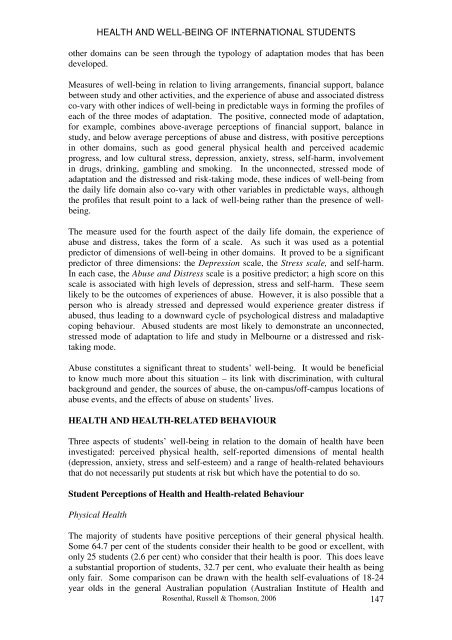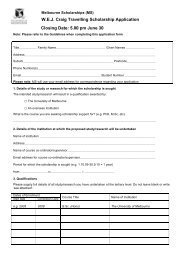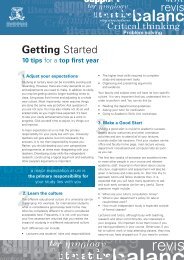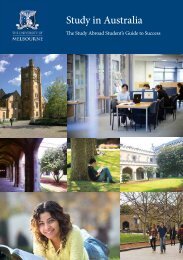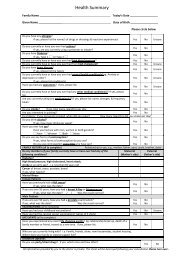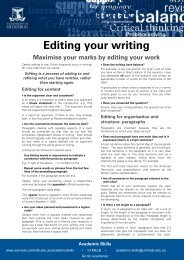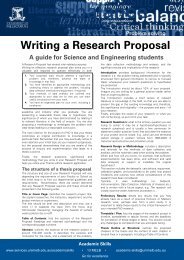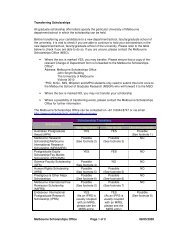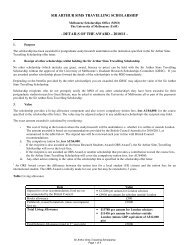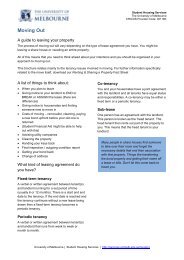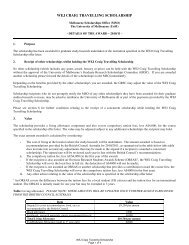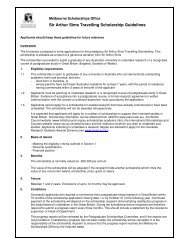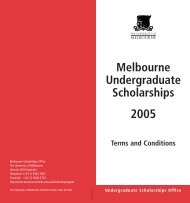a growing experience - Student Services - University of Melbourne
a growing experience - Student Services - University of Melbourne
a growing experience - Student Services - University of Melbourne
You also want an ePaper? Increase the reach of your titles
YUMPU automatically turns print PDFs into web optimized ePapers that Google loves.
HEALTH AND WELL-BEING OF INTERNATIONAL STUDENTSother domains can be seen through the typology <strong>of</strong> adaptation modes that has beendeveloped.Measures <strong>of</strong> well-being in relation to living arrangements, financial support, balancebetween study and other activities, and the <strong>experience</strong> <strong>of</strong> abuse and associated distressco-vary with other indices <strong>of</strong> well-being in predictable ways in forming the pr<strong>of</strong>iles <strong>of</strong>each <strong>of</strong> the three modes <strong>of</strong> adaptation. The positive, connected mode <strong>of</strong> adaptation,for example, combines above-average perceptions <strong>of</strong> financial support, balance instudy, and below average perceptions <strong>of</strong> abuse and distress, with positive perceptionsin other domains, such as good general physical health and perceived academicprogress, and low cultural stress, depression, anxiety, stress, self-harm, involvementin drugs, drinking, gambling and smoking. In the unconnected, stressed mode <strong>of</strong>adaptation and the distressed and risk-taking mode, these indices <strong>of</strong> well-being fromthe daily life domain also co-vary with other variables in predictable ways, althoughthe pr<strong>of</strong>iles that result point to a lack <strong>of</strong> well-being rather than the presence <strong>of</strong> wellbeing.The measure used for the fourth aspect <strong>of</strong> the daily life domain, the <strong>experience</strong> <strong>of</strong>abuse and distress, takes the form <strong>of</strong> a scale. As such it was used as a potentialpredictor <strong>of</strong> dimensions <strong>of</strong> well-being in other domains. It proved to be a significantpredictor <strong>of</strong> three dimensions: the Depression scale, the Stress scale, and self-harm.In each case, the Abuse and Distress scale is a positive predictor; a high score on thisscale is associated with high levels <strong>of</strong> depression, stress and self-harm. These seemlikely to be the outcomes <strong>of</strong> <strong>experience</strong>s <strong>of</strong> abuse. However, it is also possible that aperson who is already stressed and depressed would <strong>experience</strong> greater distress ifabused, thus leading to a downward cycle <strong>of</strong> psychological distress and maladaptivecoping behaviour. Abused students are most likely to demonstrate an unconnected,stressed mode <strong>of</strong> adaptation to life and study in <strong>Melbourne</strong> or a distressed and risktakingmode.Abuse constitutes a significant threat to students’ well-being. It would be beneficialto know much more about this situation – its link with discrimination, with culturalbackground and gender, the sources <strong>of</strong> abuse, the on-campus/<strong>of</strong>f-campus locations <strong>of</strong>abuse events, and the effects <strong>of</strong> abuse on students’ lives.HEALTH AND HEALTH-RELATED BEHAVIOURThree aspects <strong>of</strong> students’ well-being in relation to the domain <strong>of</strong> health have beeninvestigated: perceived physical health, self-reported dimensions <strong>of</strong> mental health(depression, anxiety, stress and self-esteem) and a range <strong>of</strong> health-related behavioursthat do not necessarily put students at risk but which have the potential to do so.<strong>Student</strong> Perceptions <strong>of</strong> Health and Health-related BehaviourPhysical HealthThe majority <strong>of</strong> students have positive perceptions <strong>of</strong> their general physical health.Some 64.7 per cent <strong>of</strong> the students consider their health to be good or excellent, withonly 25 students (2.6 per cent) who consider that their health is poor. This does leavea substantial proportion <strong>of</strong> students, 32.7 per cent, who evaluate their health as beingonly fair. Some comparison can be drawn with the health self-evaluations <strong>of</strong> 18-24year olds in the general Australian population (Australian Institute <strong>of</strong> Health andRosenthal, Russell & Thomson, 2006 147


